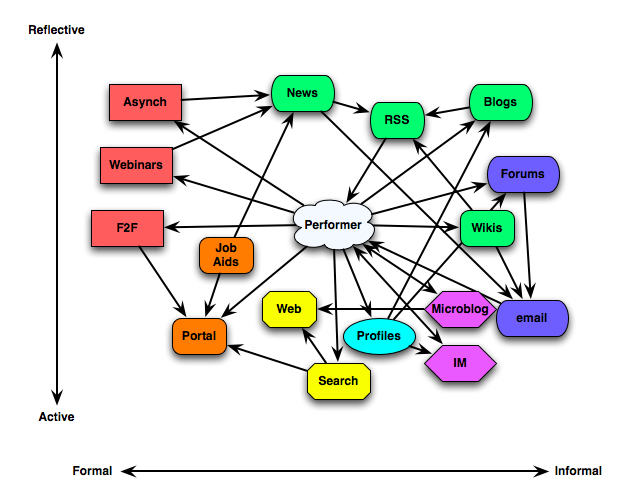Aaron Silvers (@mrch0mp3rs) wrote a post tying together the non-linear nature of cyberspace with the essentially linear nature of our past. Identifying how new technologies have to establish their own natures is a familiar refrain, but he’s comparing our learning with our new contexts, and essentially questioning the relationship between old methods and new contexts.
It was this quote which got me thinking:
communications outside of education are happening, increasingly, in hyperspace…, but our preferred methods for learning are still long-held narrative forms
I started wondering about whether we could learn without a linear narrative form, and realized we could. That is, we really do want to train certain people (e.g. pilots) to react before conscious thought kicks in. And similarly in, say, martial arts. It gets to a point where the expert creates rationales for what they’re doing that aren’t necessarily tied to the real action. We saw this in the problems that arose with ‘expert systems’, where experts articulated what they did, and then they built systems that did what the experts said, and they didn’t work.
Typically, we start off on component skills, addressing them with some explicit feedback, and gradually layer on more complex frameworks (“be the ball” :), and the performance is compiled into a deeper, really subcognitive level. We’ve used stories and feedback, and then augmented with video capture and fancy feedback machines, but we’ve kept that conscious layer of description even as it gets more abstract to match our increasingly high level of control. Our brains have evolved to process linear narrative, as we see in all the calls for incorporating story in communication. And reflection, a critical component of learning, is conscious. Now, consciousness is a still not understood linear phenomena emerging from our parallel processing brain. What would it mean to end-run linear consciousness? That’s what I started trying to imagine.
And what I came up with was a simulation game/immersive environment with non-cognitive feedback, that could train your responses. You’d be performing, and the feedback would train and integrate your responses. Yes, there’d be an explicit model of performance to guide the feedback, but the learner might not be aware of the relationships. Yes, learners would likely create a story about what’s happening (given that we’re likely to reflect consciously on what we do), but it could be wrong or they could even have their attention drawn elsewhere. So the game might even have some layer with high or little relation to what the system is training. But it could work, like in that possibly apocryphal story of the students who kept paying high quality attention to the instructor when he was on side of the room, and looked away at the other side of the room, and at the end of the lecture the instructor was way off in one corner of the room.
And what concerned me was that I wouldn’t want to have a parallel training system that bypassed or misled the conscious learning. And that’s what I raised as a comment on Aaron’s post. Not that I thought Aaron was advocating that, but it’s just where my thinking went, and he rightly queried what I was on about. I couldn’t fit it in a comment, hence this post.
The point being, there’s a role for the linear conscious narrative and reflection in our learning, just as there’s a role for dynamic multimedia networks in our learning as well. It’s finding out the balance, the role of activity and reflection, that’s the interesting and important challenge.
